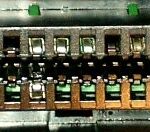The On-Board Diagnostics II (OBD2) system is a standardized protocol mandated by government regulations, primarily for emissions control, but it has become the universal gateway for accessing various vehicle modules. This standardization ensures that any diagnostic tool can read and clear data, making most functions, even those of advanced tools, accessible through OBD2. Introduced in 1996 in the USA and subsequently adopted worldwide, OBD2 revolutionized automotive diagnostics. Prior to OBD2, manufacturers often used proprietary connectors for their diagnostic tools.
Cars manufactured in the 1990s represent a transitional phase. Models like the Ferrari 360 sometimes featured both proprietary connectors and OBD2 ports. Over time, the automotive industry phased out these proprietary systems, with OBD2 becoming the dominant and often sole access point for vehicle diagnostics and module communication, including the instrument cluster, often referred to as the “Obd2 Cluster” in modern contexts. Initially, protocols like K-Line and L-Line were essential, with CAN Bus becoming mandatory later in 2008, further solidifying OBD2’s role.
Therefore, when undertaking tasks such as reprogramming an instrument cluster, for instance, converting a Ferrari 360 cluster from F1 to manual configuration, the primary access method is through the OBD2 port. It’s now established that for many modern vehicles, including performance cars of that era, instrument cluster communication and reprogramming are performed exclusively via the OBD2 interface. This standardization simplifies diagnostics and modifications, making the “obd2 cluster” a key component in automotive servicing and customization.
